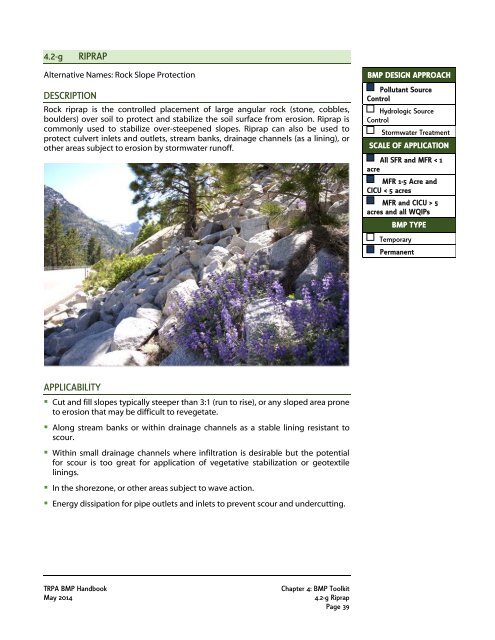4.2-g RIPRAP DESCRIPTION APPLICABILITY - Tahoe BMP
4.2-g RIPRAP DESCRIPTION APPLICABILITY - Tahoe BMP
4.2-g RIPRAP DESCRIPTION APPLICABILITY - Tahoe BMP
You also want an ePaper? Increase the reach of your titles
YUMPU automatically turns print PDFs into web optimized ePapers that Google loves.
<strong>4.2</strong>-g<br />
<strong>RIPRAP</strong><br />
Alternative Names: Rock Slope Protection<br />
<strong>DESCRIPTION</strong><br />
Rock riprap is the controlled placement of large angular rock (stone, cobbles,<br />
boulders) over soil to protect and stabilize the soil surface from erosion. Riprap is<br />
commonly used to stabilize over-steepened slopes. Riprap can also be used to<br />
protect culvert inlets and outlets, stream banks, drainage channels (as a lining), or<br />
other areas subject to erosion by stormwater runoff.<br />
<strong>BMP</strong> DESIGN APPROACH<br />
Pollutant Source<br />
Control<br />
Hydrologic Source<br />
Control<br />
Stormwater Treatment<br />
SCALE OF APPLICATION<br />
All SFR and MFR < 1<br />
acre<br />
MFR 1-5 Acre and<br />
CICU < 5 acres<br />
MFR and CICU > 5<br />
acres and all WQIPs<br />
<strong>BMP</strong> TYPE<br />
Temporary<br />
Permanent<br />
<strong>APPLICABILITY</strong><br />
• Cut and fill slopes typically steeper than 3:1 (run to rise), or any sloped area prone<br />
to erosion that may be difficult to revegetate.<br />
• Along stream banks or within drainage channels as a stable lining resistant to<br />
scour.<br />
• Within small drainage channels where infiltration is desirable but the potential<br />
for scour is too great for application of vegetative stabilization or geotextile<br />
linings.<br />
• In the shorezone, or other areas subject to wave action.<br />
• Energy dissipation for pipe outlets and inlets to prevent scour and undercutting.<br />
TRPA <strong>BMP</strong> Handbook<br />
May 2014<br />
Chapter 4: <strong>BMP</strong> Toolkit<br />
<strong>4.2</strong>-g Riprap<br />
Page 39
Advantages<br />
• Versatile and applicable for many applications.<br />
• When installed correctly, riprap can be highly effective at hindering erosion<br />
and stabilizing soils.<br />
• When used to line small drainage channels, riprap provides a stable channel<br />
structure and reduces stormwater velocities.<br />
• Allows for seeding or inter-planting between rocks.<br />
Disadvantages<br />
• Displacement of riprap may occur:<br />
• On steep slopes typically greater than 1.5:1 (run to rise).<br />
• If riprap is too small.<br />
• If the toe is not stabilized properly or if riprap is not correctly installed.<br />
• Displacement occurring adjacent to roadsides may present a safety hazard.<br />
• Installation without successful revegetation results in a barren appearance<br />
that is typically considered a poor aesthetic.<br />
• The cost of hauling rock can make riprap a relatively expensive compared to<br />
other stabilization techniques.<br />
DESIGN CONSIDERATIONS<br />
• Typically applied when revegetation success is unlikely for slopes steeper than<br />
3:1 (run to rise). Displacement and constructability issues are concerns for riprap<br />
on slopes typically steeper than 1.5:1.<br />
• When designing a channel lining with riprap, ensure that design calculations<br />
consider potential reductions in channel capacity caused by the riprap.<br />
• Use durable angular rock and avoid rounded stones or cobbles.<br />
• Ensure that the color of Riprap is compatible with the surroundings. Select colors<br />
from the Munsell® colors set forth in Appendix G, TRPA Approved Range of<br />
Earthtone Colors, of the TRPA Design Review Guidelines.<br />
• For complicated applications, consult with a licensed professional civil engineer<br />
to design riprap based on drainage computations, slope conditions, soil<br />
conditions, and other constructability issues. For simple applications the<br />
following design guidelines may be followed:<br />
• Riprap should be sound, dense, and durable angular rock with a minimum<br />
specific gravity of 2.6.<br />
• Riprap ranges in size from 9 inches to 18 inches. Smaller size rock is typically<br />
not appropriate.<br />
INSTALLATION CONSIDERATIONS<br />
• If desired, broadcast seed before rock placement. Consider provisions to control<br />
weed establishment in riprap prior to installation.<br />
• Remove ground cover, litter, and smaller woody vegetation. Retain larger trees<br />
and shrubs where desirable, around which rock should be placed by hand.<br />
Chapter 4: <strong>BMP</strong> Toolkit<br />
TRPA <strong>BMP</strong> Handbook<br />
<strong>4.2</strong>-g Riprap May 2014<br />
Page 40
• Compact subgrade to prevent slumping or undercutting where feasible. Place<br />
riprap by hand or using mechanized equipment.<br />
• A gravel filter layer or geotextile filter fabric layer is typically placed prior to<br />
riprap placement to maintain separation between the rock material and the<br />
underlying soil, which prevents soil loss and provides a bed to allow easier<br />
placement of rock.<br />
• Gravel filter layer: A layer of well-compacted gravel provides a smooth bed to<br />
allow easier placement of riprap. A few inches of gravel is typically sufficient<br />
as a filter layer.<br />
• Geotextile filter fabric layer: A filter fabric layer is typically easier to install on<br />
steeper slopes relative to a gravel filter layer, but it is more difficult to bed the<br />
rock relative to a gravel filter layer. Place the filter fabric so that it is not<br />
stretched and conforms closely to the subgrade. Secure filter fabric by using<br />
anchor trenches, stakes, staples, or other means necessary according to the<br />
manufacturer’s recommendations. Bury the upper portion of the filter fabric<br />
and the toe of the filter fabric to prevent unraveling.<br />
• Typically, the riprap layer should be at least twice as thick as the maximum rock<br />
diameter used. Rocks should be securely bedded in contact to one another, with<br />
larger rocks uniformly distributed and smaller rocks filling the voids.<br />
• Ensure that the slope above the riprap is stable to prevent sloughing and failure<br />
of the slope into the riprap section.<br />
INSPECTION AND MAINTENANCE<br />
Refer to Riprap Inspection and Maintenance Table for inspection and maintenance<br />
protocols.<br />
EFFECTIVENESS CONSIDERATIONS<br />
Rock riprap can be highly effective at preventing soil erosion from steep slopes.<br />
When properly installed, rock riprap can be effective for long periods of time while<br />
requiring minimal maintenance. Riprap is more broadly accepted from an aesthetic<br />
standpoint when vegetation is established throughout the riprap.<br />
TRPA <strong>BMP</strong> Handbook<br />
May 2014<br />
Chapter 4: <strong>BMP</strong> Toolkit<br />
<strong>4.2</strong>-g Riprap<br />
Page 41
Riprap Inspection and Maintenance Table<br />
INSPECTION AND MAINTENANCE ACTIVITIES<br />
SUGGESTED<br />
FREQUENCY<br />
INSPECTION<br />
EQUIPMENT<br />
MAINTENANCE<br />
EQUIPMENT<br />
Inspect for trash and unwanted debris.<br />
• Remove trash and unwanted debris from the area.<br />
Inspect for soil erosion and accumulation, especially at the top and bottom of the slope.<br />
• Remove accumulated sediment with shovel, backhoe, or vactor truck.<br />
• Dispose of sediment at a TRPA approved stable on-site location or out of the Lake <strong>Tahoe</strong> Region.<br />
• Stabilize eroded and undercut areas.<br />
• If upslope soil is overtopping treatment repeatedly, extend rock to hinge of slope.<br />
Monthly (April—Oct)<br />
Monthly (April—Oct)<br />
Trash bag<br />
Shovel, Backhoe, or<br />
Vactor Truck<br />
Additional Rock<br />
Inspect for invasive weeds 11 .<br />
• Remove invasive weeds monthly during the first two growing seasons. Thereafter, weed annually, or as<br />
needed.<br />
Inspect for animal burrows, holes and mounds.<br />
• If burrows are causing erosion or compromising structural integrity, backfill firmly. It may be necessary to<br />
chink void spaces with smaller rock.<br />
Inspect for dislodged or unstable rock which could pose safety hazards.<br />
• Repair dislodged or unstable rock.<br />
Inspect site for unusual or unsafe conditions (snowplow damage, structural damage, dumping, tree<br />
establishment, etc.).<br />
• Repair or replace rock as necessary.<br />
Monitor ongoing effectiveness and determine whether another <strong>BMP</strong> type or additional rock could improve<br />
long-term effectiveness and improve benefits to costs versus the existing rock slope protection.<br />
• Analyze Inspection and Maintenance Log for trends and recurring issues.<br />
• Prepare a plan that more effectively addresses slope stabilization, reduces long term maintenance costs,<br />
and improves overall effectiveness and safety of the <strong>BMP</strong>.<br />
Monthly during first<br />
growing season and<br />
annually thereafter<br />
Annually in fall after<br />
vegetation trimming<br />
Annually in spring<br />
Annually in spring<br />
Every 5 years<br />
Invasive Weeds<br />
Inspector<br />
Qualified Inspector<br />
or Consultant<br />
Tools as needed to<br />
control infestation<br />
Tools as needed to<br />
repair<br />
Additional Rock<br />
Tools as needed<br />
Qualified Inspector<br />
or Consultant<br />
11<br />
Lake <strong>Tahoe</strong> Basin Weed Coordinating Group. http://www.tahoeinvasiveweeds.org/.<br />
Chapter 4: <strong>BMP</strong> Toolkit<br />
TRPA <strong>BMP</strong> Handbook<br />
<strong>4.2</strong>-g Riprap May 2014<br />
Page 42
Riprap Slope Protection Figure<br />
THE TAHOE REGIONAL PLANNING AGENCY (TRPA) SHALL NOT BE RESPONSIBLE FOR THE ACCURACY OR COMPLETENESS OF ELECTRONIC COPIES OF THIS DETAIL.<br />
TRPA <strong>BMP</strong> Handbook<br />
May 2014<br />
Chapter 4: <strong>BMP</strong> Toolkit<br />
<strong>4.2</strong>-g Riprap<br />
Page 43
Chapter 4: <strong>BMP</strong> Toolkit<br />
TRPA <strong>BMP</strong> Handbook<br />
<strong>4.2</strong>-g Riprap May 2014<br />
Page 44

















